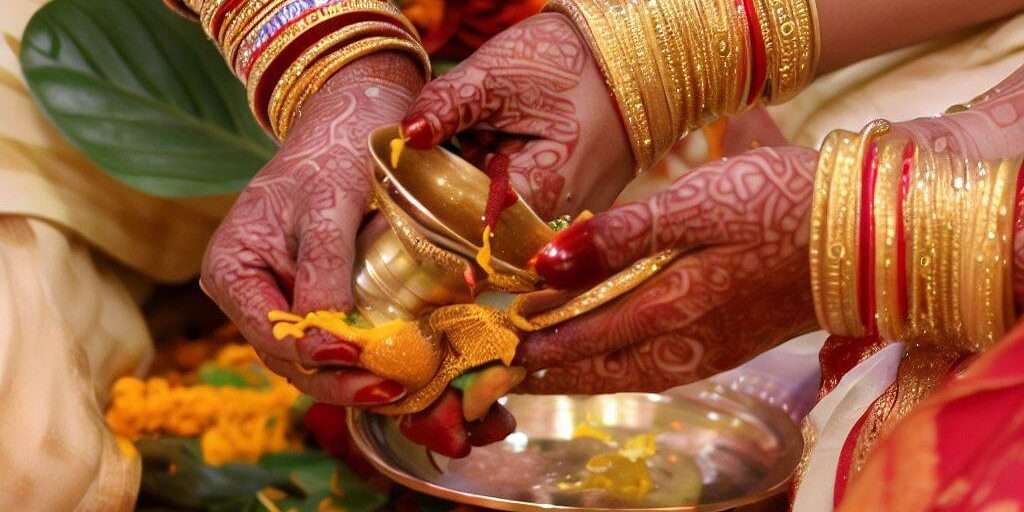Unveiling the Sacred Traditions: Exploring the Symbolism of 12 Hindu Wedding Rituals


A Traditional Hindu Wedding Ceremony – The Epitome of Cultural Heritage and Spiritual Symbolism
Introduction
Hindu weddings, an exuberant medley of traditional customs, vibrant colors, and captivating rituals, offer a fascinating blend of solemnity and festivity. They reflect the profundity of the culture, and more importantly, they mark the sacred union of two souls embarked on a lifelong journey of togetherness. In essence, these weddings aren’t merely ceremonies; they are carefully curated tapestries of spiritual progression, social bonds, and personal commitments.
In this blog post, we delve deep into the symbolism of 12 Hindu Wedding Rituals, unraveling their cultural and spiritual significance and shedding light on their timeless relevance in contemporary society.
Pre-Wedding Rituals
Mangalasnanam (Sacred Bath)
The pre-wedding rituals commence with the Mangalasnanam or the sacred bath. Historically rooted in ancient Hindu scriptures, the ritual involves the bride and groom taking a purifying bath on the morning of the wedding day. This bath is intended to cleanse them of any negativity, purifying their body and soul before the commencement of the marriage rites. It’s believed to wash away past sins and impurities, symbolizing a fresh start for their impending marital journey. Sacred herbs and medicated oils often accompany the bath, adding a layer of sanctity to the purification process.
Ganesh Puja (Invocation of Lord Ganesha)
Ganesh Puja forms an integral part of Hindu wedding rituals, emphasizing the deep-rooted faith in divine intervention and blessings. Lord Ganesha, revered as the god of beginnings and the remover of obstacles, is invoked before the start of the wedding proceedings. The families gather to offer prayers, seeking His blessings for a smooth, problem-free wedding ceremony. This ritual aims to set a positive and auspicious tone, paving the way for a blissful marital life.
Sagan (Exchange of Gifts)
Sagan is a ritual of acceptance and mutual respect. This ceremony involves the exchange of gifts between the bride and groom’s families, marking their acceptance of the marriage. Gifts may range from jewelry, clothes, and fruits to sweets and cash, symbolizing prosperity and happiness. The act of giving and receiving gifts underscores the significance of sharing and unity in Hindu culture. It serves as a testament to the strengthening of familial ties and the merging of two families into one.
Mehndi (Henna Ceremony)
The Mehndi ceremony, one of the most visually captivating pre-wedding rituals, involves the application of intricate henna designs on the bride’s hands and feet. Friends and family surround the bride during this festive ritual, filling the air with laughter, music, and the sweet aroma of henna. The elaborate patterns symbolize beauty, joy, and spiritual awakening. Moreover, the deep reddish-brown hue of the henna signifies the depth of love and affection between the couple.
Wedding Day Rituals
Baraat (Groom’s Procession)
The Baraat marks the arrival of the groom at the wedding venue. It is a vivacious procession filled with music, dancing, and merriment, representing the groom’s journey from his home to the bride’s. This procession can comprise family members, friends, and hired musicians. The groom usually arrives on a decorated horse or car, indicating his readiness to take up his marital responsibilities.
Var Puja (Groom’s Welcome)
Upon the Baraat’s arrival, the bride’s family extends a formal welcome in a ceremony known as the Var Puja. The mother of the bride performs the Aarti, a ritual that involves circling a lighted lamp around the groom’s face to ward off evil spirits. The groom is then offered sweets and a drink, typically a concoction of milk, ghee, and honey, symbolizing the sweetness of the familial bond being formed.
Kanyadaan (Giving Away the Bride)
Kanyadaan is an emotionally charged moment, steeped in cultural symbolism and parental sentiment. It signifies the ritual handover of the bride by her parents to the groom. The parents of the bride place their daughter’s hand into the groom’s, entrusting him with their most precious gem. This momentous ritual signifies the acceptance of a new responsibility by the groom – to love, care, and protect his wife.
Saptapadi (Seven Sacred Steps)
Saptapadi, or the Seven Sacred Steps, is the core ritual of a Hindu wedding. The couple, hand-in-hand, takes seven rounds around the sacred fire, signifying the seven vows of Hindu marriage. Each round corresponds to a specific vow, ranging from providing for the family, maintaining physical and mental health, to fostering love, respect, and lifelong companionship. The fire acts as a divine witness to these vows, sealing the bond of matrimony.
Mangalsutra (Sacred Necklace)
The ritual of Mangalsutra involves the groom tying a sacred necklace around the bride’s neck. The Mangalsutra, comprising gold and black beads, is a symbolic representation of the couple’s marital status. It serves as a token of love, respect, and marital bond. The black beads are believed to ward off evil and bring prosperity, while the gold represents the purity of the marriage.
Sindoor (Vermilion Application)
In the Sindoor Daan ceremony, the groom applies vermilion, or sindoor, in the bride’s hair parting. This age-old practice marks the culmination of the wedding rituals, symbolizing the bride’s transition into a married woman. The red color of the sindoor is believed to denote power and prosperity, indicating the groom’s promise to protect and care for his wife.
Post-Wedding Rituals
Grihapravesh (Homecoming)
Grihapravesh marks the entry of the newlywed bride into her marital home. Symbolizing her transition into a new phase of life, the ritual involves the mother-in-law welcoming the bride with an Aarti. The bride, usually with her right foot, knocks over a pot filled with rice at the entrance. This act symbolizes the ushering in of prosperity and good luck into her new home.
Mooh Dikhai (Bride’s Unveiling)
Mooh Dikhai, literally translating to ‘showing of the face,’ is a post-wedding ritual where the bride is formally introduced to the groom’s family. Traditionally, the bride keeps her face partially veiled during the wedding ceremonies. In Mooh Dikhai, the veil is lifted, symbolizing her acceptance into the new family. Family members present the bride with gifts and blessings, signifying their acceptance and love.
Reception (Wedding Celebration)
The reception is a grand social gathering held after the completion of the wedding rituals. It’s an opportunity for friends and family to come together, celebrate the newlyweds, and indulge in festivities and feasting. The event usually includes a grand feast, music, and dance, symbolizing the joyous conclusion of the wedding ceremonies.
Summary
The 12 Hindu Wedding Rituals form a spiritual journey that beautifully encapsulates the essence of the Hindu philosophy of life, love, and spiritual growth. Each ritual, replete with symbolic meaning, paves the way for the couple to embark on their new journey together. While their manifestation may vary across regions, these rituals share a common thread – they celebrate the sacred bond of marriage, the union of two souls, and two families.
FAQs
What is the importance of Hindu wedding rituals?
Hindu wedding rituals are much more than traditional customs – they are a symphony of spiritual affirmations, social responsibilities, and personal commitments. Each ritual carries profound symbolic meaning, guiding the couple towards a fulfilling marital life. They affirm the values of love, respect, fidelity, and togetherness, providing a moral and spiritual framework for the couple’s journey ahead.
How long does a Hindu wedding ceremony typically last?
The duration of a Hindu wedding can vary greatly based on regional customs and personal preferences. While the main wedding ceremony can last a few hours to a whole day, the entire series of pre-wedding, wedding, and post-wedding rituals can span several days, even a week. It’s a period of joyous celebrations, solemn rituals, and heartfelt moments shared with loved ones.
Are all the 12 rituals performed in every Hindu wedding?
While the 12 rituals discussed here form the backbone of a traditional Hindu wedding, the actual number and sequence of rituals can vary based on regional customs, caste practices, and familial traditions. Some families may incorporate additional rituals, while others might streamline the ceremonies as per their preferences. However, the core essence of celebrating the marital union remains a constant in all Hindu weddings.
What is the significance of the sacred fire in Hindu weddings?
The sacred fire, or Agni, plays a pivotal role in Hindu weddings. It is seen as a divine witness to the marriage, a purifier, and a conveyor of offerings to the gods. The rituals involving the sacred fire, such as the Saptapadi, are of immense spiritual significance, symbolizing the divine sanctioning of the marital bond.
Can non-Hindus participate in Hindu wedding rituals?
Non-Hindus are often welcomed at Hindu weddings to partake in the celebrations and witness the rich tapestry of rituals. However, active participation in certain religious ceremonies might depend on the specific customs followed by the host family and their comfort level.
Conclusion
The myriad Hindu Wedding Rituals, each imbued with deep cultural significance and spiritual symbolism, provide a fascinating glimpse into the rich tapestry of Hindu culture. As we continue to witness these rituals in modern times, their timeless wisdom and enduring relevance remind us of the profound philosophical underpinnings of Hindu thought. Whether it’s the spiritual cleansing of the Mangalasnanam or the binding commitment of the Saptapadi, these rituals invite us to explore and appreciate the profound wisdom encapsulated in Hindu wedding traditions.
Further reading
What’s a Hindu wedding like?: https://www.hinduamerican.org/hindu-wedding-primer
Recent Posts
5 Key Insights: The Significance of Yoga in Modern Life from a Hindu Perspective
Yoga, an ancient practice rooted deeply in the spiritual soil of Hinduism, has traversed a…
10 Transformative Reasons: The Spiritual Guide to Eating with Hands in Hinduism
Introduction In the age of fast food and instant gratification, the serene practice of eating…
10 Unbreakable Connections Between Hinduism and Environmental Sustainability: A Comprehensive Guide
Introduction Hinduism, one of the world's oldest religions, is more than a mere spiritual path;…
7 Timeless Principles of Non-Violence in Hinduism: A Comprehensive Guide
Introduction: Embracing Non-Violence in Hinduism The Profound Connection Between Non-Violence and Hinduism Non-violence, or Ahimsa,…
7 Transformative Powers of Yagya in Hinduism: A Complete Guide to Spiritual Rituals
Introduction to Yagya in Hinduism: A Spiritual Exploration Yagya, also spelled Yajna, is a profound…
The Deep-rooted Significance of Copper in Hinduism: 7 Enlightening Insights
Introduction Copper, with its gleaming reddish-brown allure, isn't just a metal to the spiritually profound…


View Comments